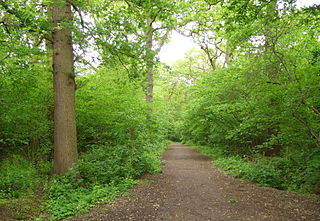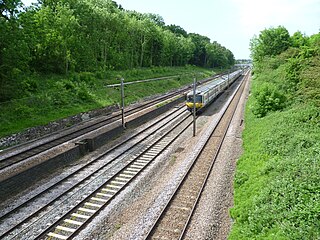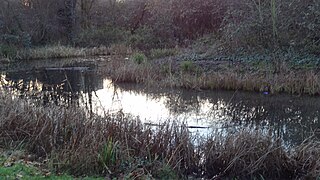Related Research Articles

Human ecology is an interdisciplinary and transdisciplinary study of the relationship between humans and their natural, social, and built environments. The philosophy and study of human ecology has a diffuse history with advancements in ecology, geography, sociology, psychology, anthropology, zoology, epidemiology, public health, and home economics, among others.

Urban ecology is the scientific study of the relation of living organisms with each other and their surroundings in the context of an urban environment. The urban environment refers to environments dominated by high-density residential and commercial buildings, paved surfaces, and other urban-related factors that create a unique landscape dissimilar to most previously studied environments in the field of ecology. The goal of urban ecology is to achieve a balance between human culture and the natural environment.

Lee Valley Regional Park is a 10,000-acre (40 km2) 26 miles (42 km) long linear park, much of it green spaces, running through the northeast of Greater London, Essex and Hertfordshire from the River Thames to Ware, through areas such as Stratford, Clapton, Tottenham, Enfield, Walthamstow, Cheshunt, Broxbourne and Hoddesdon in an area generally known as the Lea Valley. Greater London's largest park, Lee Valley Park is more than four times the size of Richmond Park, extending beyond Greater London's borders into the neighbouring counties of Hertfordshire and Essex.
The British Ecological Society is a learned society in the field of ecology that was founded in 1913. It is the oldest ecological society in the world. The Society's original objective was "to promote and foster the study of Ecology in its widest sense" and this remains the central theme guiding its activities today. The Society had, circa 2013 around 4,000 members of which 14% are students. It has always had an international membership and currently 42% are outside the United Kingdom, in a total of 92 countries. The head office is located in London.

Restoration ecology is the scientific study supporting the practice of ecological restoration, which is the practice of renewing and restoring degraded, damaged, or destroyed ecosystems and habitats in the environment by active human intervention and action. Effective restoration requires an explicit goal or policy, preferably an unambiguous one that is articulated, accepted, and codified. Restoration goals reflect societal choices from among competing policy priorities, but extracting such goals is typically contentious and politically challenging.

Russia Dock Woodland is a long narrow park in Rotherhithe, London, created by the infilling of one of the former Surrey Commercial Docks. The former Russia Dock was originally used for the importing of softwood timber from Norway, Russia and Sweden. Known as "deal wood", it was mostly used for newsprint and for manufacturing furniture.

Shoreditch High Street is the old main street of Shoreditch, London. It is part of the A10 road and connects Norton Folgate to the south with Kingsland Road to the north. It constitutes a segment of the Roman Ermine Street, which ran directly north from London to Lincoln and York. The parish church of St Leonard's, Shoreditch is situated at the north-east end of the road, at the crossroads where it meets with Hackney Road.

Pymmes Brook is located in North London and named after William Pymme, a local land owner. It is a minor tributary of the River Lea. The brook mostly flows through urban areas and is particularly prone to flooding in its lower reaches. To alleviate the problem the brook has been culverted in many areas. Part of it is a Site of Borough Importance for Nature Conservation, Grade II.

Campden Hill is a hill in Kensington, West London, bounded by Holland Park Avenue on the north, Kensington High Street on the south, Kensington Palace Gardens on the east and Abbotsbury Road on the west. The name derives from the former Campden House, built by Baptist Hicks, 1st Viscount Campden whose country seat was Campden House in the Gloucestershire town of Chipping Campden.
The Trust for Urban Ecology (TRUE) is a London-based ecological organisation and is part of The Conservation Volunteers. The Trust for Urban Ecology was founded in 1976 when ecologist Max Nicholson and a group of like-minded conservationists set up Britain's first urban ecology park.

Darland's Lake Nature Reserve is a nature reserve south of Totteridge Village in Barnet, England. It is owned by the London Borough of Barnet and was managed from 1971 by the Hertfordshire and Middlesex Wildlife Trust, and more recently by the borough council. In 2007 the council spent £215,000 on repairing the dam and other works, and then proposed leasing the reserve to the Wildlife Trust. The transfer did not take place and in September 2017 a trust was set up by the London Wildlife Trust and local residents associations which took over the management of Darland's Lake. In 2020 Darlands Conservation Trust launched an appeal to raise £450,000 for excavation to prevent the lake drying up.

Rowley Green Common is a six hectare Local Nature Reserve and a Site of Importance Metropolitan for Nature Conservation in Arkley, north London. It is owned by the London Borough of Barnet and according to the Natural England details page it is jointly managed by the Hertfordshire and Middlesex Wildlife Trust and the London Wildlife Trust, but as of August 2015 it is not on the list of reserves of either Trust. It is also registered common land.

Southwark St Olave was an ancient civil and ecclesiastical parish on the south bank of the River Thames, covering the area around where Shard London Bridge now stands in the modern London Borough of Southwark. The boundaries varied over time but in general the parish stretched east from London Bridge past Tower Bridge to St Saviour's Dock. Southwark St Olave and St Thomas replaced the civil parish in 1896. It was abolished in 1904 and absorbed by Bermondsey parish.

Scratchwood is an extensive, mainly wooded, country park in Mill Hill in the London Borough of Barnet. The 57-hectare site is a Site of Metropolitan Importance for Nature Conservation and together with the neighbouring Moat Mount Open Space. It is a Local Nature Reserve.

Avenue House Grounds is a ten-acre Site of Local Importance for Nature Conservation on East End Road in Church End, Finchley in the London Borough of Barnet. The estate is now known as Stephens House and Gardens.

Big Wood and Little Wood are two patches of woodland in Hampstead Garden Suburb in the London Borough of Barnet. They are a Site of Borough Importance for Nature Conservation, Grade 1, and a Local Nature Reserve. Big Wood is 7.3 hectares and Little Wood is 1.2 hectares.

Oakleigh Park Rail Cutting is an 8 hectare Site of Local Importance for Nature Conservation in Oakleigh Park in the London Borough of Barnet. It is on the East Coast Main Line between Oakleigh Park railway station and Barnet Tunnel to its south.

Dulwich Upper Wood is a 2.4 hectare local nature reserve and Site of Borough Importance for Nature Conservation, Grade 1, in Crystal Palace in the London Borough of Southwark. It is owned by Southwark Council and managed by the Trust for Urban Ecology.

Gillespie Park is a 3.4 hectare Local Nature Reserve and Site of Metropolitan Importance for Nature Conservation in Highbury in the London Borough of Islington. It also hosts the Islington Ecology Centre, which provides environmental education for schools and organises walks and talks for adults. It is owned and managed by Islington Council. The site is protected by Fields in Trust through a legal "Deed of Dedication" safeguarding the future of the space as public recreation land for future generations to enjoy.

Sutton Ecology Centre Grounds is a 1.3 hectare Local Nature Reserve and Site of Borough Importance for Nature Conservation, Grade 1, in Carshalton in the London Borough of Sutton. It is owned by Sutton Council and managed by the Council together with the Friends of Sutton Ecology Centre.
References
Coordinates: 51°30′16″N0°4′39″W / 51.50444°N 0.07750°W